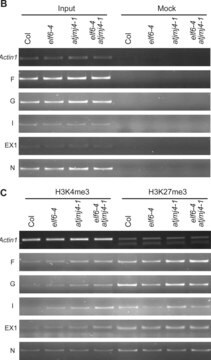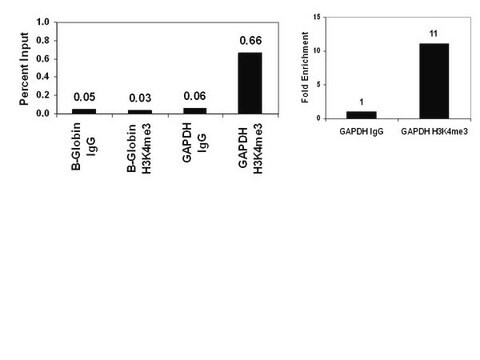05-1339
Anti-Trimethyl Histone H3 (Lys4) Antibody, clone CMA304
clone CMA304, from mouse
Sinonimo/i:
H3K4me3, Histone H3 (tri methyl K4), H3 histone family, member T, histone 3, H3, histone cluster 3, H3
About This Item
Prodotti consigliati
Origine biologica
mouse
Livello qualitativo
Forma dell’anticorpo
purified antibody
Tipo di anticorpo
primary antibodies
Clone
CMA304, monoclonal
Reattività contro le specie
human, vertebrates
tecniche
ELISA: suitable
dot blot: suitable
immunocytochemistry: suitable
immunoprecipitation (IP): suitable
multiplexing: suitable
western blot: suitable
Isotipo
IgG1κ
N° accesso NCBI
N° accesso UniProt
Condizioni di spedizione
wet ice
modifica post-traduzionali bersaglio
trimethylation (Lys4)
Informazioni sul gene
human ... H3C1(8350)
Descrizione generale
Specificità
Immunogeno
Applicazioni
This antibody has been shown by an outside laboratory to be suitable for ELISA.1
Immunocytochemistry:
This antibody has been shown by an outside laboratory to be suitable for immunocytochemistry.1
Immunoprecipitation:
This antibody has been shown by an outside laboratory to be suitable for immunoprecipitation.1
Multiplexing:
This antibody specifically recognizes histone H3 trimethylated on Lys4 by Luminex® assay.
Epigenetics & Nuclear Function
Histones
Qualità
0.5 - 2 μg/mL (1:500-2000) dilution of this antibody detected trimethyl Histone H3 (Lys4) on 10 μg of HeLa acid extract.
Descrizione del bersaglio
Linkage
Stato fisico
Stoccaggio e stabilità
Risultati analitici
HeLa Acid extract lysate
Altre note
Note legali
Esclusione di responsabilità
Non trovi il prodotto giusto?
Prova il nostro Motore di ricerca dei prodotti.
Raccomandato
Codice della classe di stoccaggio
10 - Combustible liquids
Classe di pericolosità dell'acqua (WGK)
WGK 2
Punto d’infiammabilità (°F)
Not applicable
Punto d’infiammabilità (°C)
Not applicable
Certificati d'analisi (COA)
Cerca il Certificati d'analisi (COA) digitando il numero di lotto/batch corrispondente. I numeri di lotto o di batch sono stampati sull'etichetta dei prodotti dopo la parola ‘Lotto’ o ‘Batch’.
Possiedi già questo prodotto?
I documenti relativi ai prodotti acquistati recentemente sono disponibili nell’Archivio dei documenti.
Il team dei nostri ricercatori vanta grande esperienza in tutte le aree della ricerca quali Life Science, scienza dei materiali, sintesi chimica, cromatografia, discipline analitiche, ecc..
Contatta l'Assistenza Tecnica.








